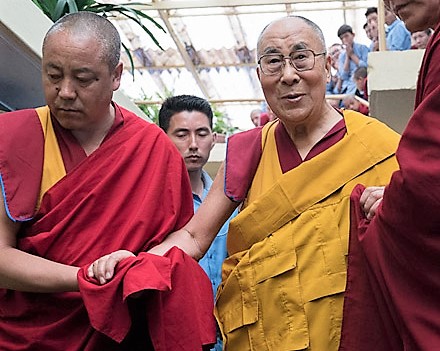 Thekchen Chöling, Dharamsala, HP, India – After storms in the night, the morning was cool as His Holiness the Dalai Lama walked through the yard to take his seat in the temple. He asked for the day’s debate demonstration to begin immediately and students from Sherab Gatsel Lobling School opened with a discussion of the awakening mind of bodhichitta.
Thekchen Chöling, Dharamsala, HP, India – After storms in the night, the morning was cool as His Holiness the Dalai Lama walked through the yard to take his seat in the temple. He asked for the day’s debate demonstration to begin immediately and students from Sherab Gatsel Lobling School opened with a discussion of the awakening mind of bodhichitta.
“Today we’ll read the ‘Commentary on the Awakening Mind’,” His Holiness began. “It starts by reviewing various different philosophical positions and towards the end deals with the conventional awakening mind that you have just been discussing. First, I’d like everyone to recite the ‘Praise to the Seventeen Nalanda Masters’.”
Introducing the texts he was going to read, His Holiness explained that the ‘Commentary on the Awakening Mind’ is short, but deals with the full range of the Buddha’s teachings. He said he’d chosen the second work, the ‘Thirty-seven Practices’ by the Bodhisattva Thogme Sangpo, as a model for daily practice.
His Holiness observed that another of Nagarjuna’s treatises, the ‘Jewel Garland’ distinguishes between practices that lead to high status or better rebirth and those that lead to liberation.
He observed that since all religions encourage us to develop love and compassion and to help other human beings, their practice qualifies as giving rise to better rebirth. He then quoted Aryadeva’s ‘400 Verses’:
First prevent the demeritorious,
Next prevent [ideas of a coarse] self;
Later prevent views of all kinds.
Whoever knows of this is wise.
To start with, Nagarjuna refers to the ultimate awakening mind, not just the mind that realizes emptiness directly, but that awareness from which all gross states of mind have been eliminated and only the subtle clear light remains.
As he read rapidly through the text His Holiness pointed out where verses refuted the views of non-Buddhists, where they challenged the view of the Mind Only School and where they assert existence only as designation:
The mind is but a mere name;
Apart from its name it exists as nothing;
View consciousness as a mere name;
Name too has no intrinsic nature.
He also pointed out where the text deals with the awakening mind as an altruistic aspiration for enlightenment and further down where it outlines the twelve deeds of a Buddha. When he came to the following verse:
The single taste of compassion is merit;
The taste of emptiness is most excellent;
Those who drink [the elixir of emptiness] to realize
Self and other’s welfare are conqueror’s children,
His Holiness remarked, “This is the practice I try to follow and I have friends who do it too. We find that it’s very beneficial. Since, you have the opportunity you could try to follow it as well. If we uphold the Dharma on the basis of reason it will live a long time—and that will be source of real contentment.”
He then led the gathering in a simple ceremony for generating the awakening mind. At the end he appealed to everyone present to share the idea of the oneness of humanity with ten friends, calculating that if they each did the same the result would be to spread the message far and wide.
Although he declared that the teachings were over, His Holiness remained in the temple while first the visiting Thai Abbot, his monks and lay-followers and then all the Tibetan students had their photographs taken with him in groups. After that, greeting friends and well-wishers as he went, he returned to his residence.
https://www.dalailama.com/news/2017/teachings-for-tibetan-youth-conclude